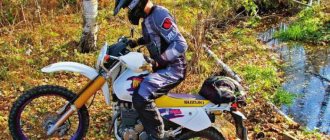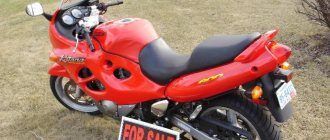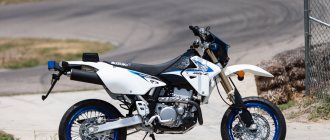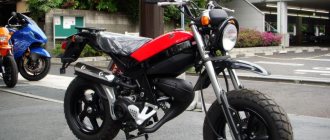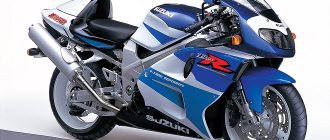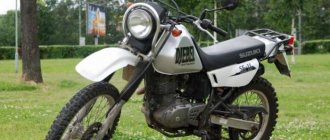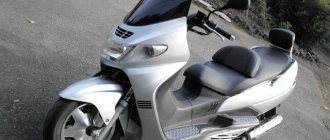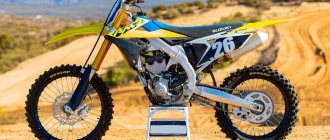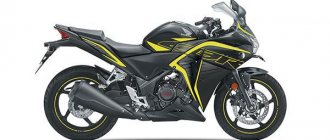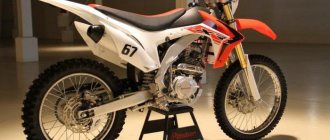Seeing the successful sales of the Italians (Aprilia Pegaso 650) and Germans (BMW F650) the Japanese did not want to lag behind, and in 1997 Suzuki concern presented its version of the 650 cc bike. The model was called “free wind” or Suzuki XF 650 Freewind. As competitors, they classified it in the touring-enduro class.
The production continued for 5 years. In 2001, production closed.
For comparison, the Germans started in 1993 , finished in 2007 , and the Italians still keep their Pegasus on the assembly line, updating and creating new modifications.
It’s interesting that the front of the Japanese is very reminiscent of Aprila, and the back of the Boomer. A sort of hybrid .
Technical characteristics (power plant)
In terms of power, the Suzuki engine is slightly inferior to the Rotax model, so beloved by its competitors, but at the same time it beats it in terms of maintainability, thanks to simple air cooling and a classic distribution scheme in the cylinder head.
Engine – left view.
Engine – right side view.
He has:
- working volume - 644 cm3;
- number of cylinders - 1;
- number of cycles - 4;
- number of valves - 4;
- power - 48 hp;
- torque - 51 Nm;
- cooling - air (SACS);
- fuel supply - carburetor;
- ignition - digital (CDI);
- start - electric starter;
- Tank volume - 18.5 l. (reserve - 4.5).
According to user reviews, the bike has no complaints 92 gasoline
Transmission and clutch
The motorcycle was equipped with a 5-speed gearbox .
According to user reviews, it did not create any problems, and during normal driving you can immediately click into 5th gear, and then ride like on a scooter, adjusting only with the throttle.
- Main drive - chain (standard).
On this model, you need to keep an eye on the chain, otherwise it will rub the pendulum.
- Multi-plate clutch , oil bath, power transmission - cable .
Brakes
Traditionally, “large” Japanese bikes have hydraulic support and discs on both wheels.
Front brakes.
Rear brakes.
Front brakes:
- number of disks - 1;
- diameter - 300 mm;
- support - 2-piston.
Rear brakes:
- number of disks - 1;
- diameter - 240 mm;
- support - 1-piston.
Since production of the model was closed before the widespread use of some kind of braking assistance systems, the motorcycle has no options , and the stock package does not include them.
Motorcycle Suzuki XF650 Freewind
19.06.2003
Suzuki Freewind XF650 is a universal motorcycle for a beginner, it will always help and advise, it can “do everything” on any terrain... It seems that Suzuki engineers have always been able to create worthwhile motorcycles. It's surprising why they still didn't have such a versatile motorcycle in their pipeline. Now you can get acquainted with the new 1997 Suzuki XF650 Freewind, a real motorcycle that can do it all.
Naturally, the meaning of this word depends on your own definition of the perfect motorcycle. But we won't talk exclusively about commuting on city streets, as there's a new breed of "standard" motorcycles like the Suzuki Bandit for that. Also, our motorcycle must be adapted to tourist trips, and to the ability to take on a broken road and even just a temporary shelter, so as to exclude most dual-purpose vehicles from the analysis list.
For many Europeans and Americans, there was previously only one answer to this - the BMW F650. This bike has topped the European commercial charts for the past few years and could do the same in the US.
The Japanese have never been in a hurry to catch up with this trend, but even now Suzuki is engaged in manipulation. And their prices simply blow away BMW's market niche. The design of the motorcycle was created very simply. The engine chosen first was the DR650, a successful dual-purpose motorcycle. It was mounted on a lower frame, and the bike itself was equipped with an abundance of hard-road-oriented features, such as a durable and massive body, an efficient fairing and a 19-inch front wheel.
What is the result? This Japanese motorcycle, created over the past few years, has a very European look. And with the smaller badge, the Freewind looks more like a whimsical sculpture by the famous Italian designer than a big four-cylinder commuter. Having met the motorcycle on the street, most spectators generally refused to believe that the amazing curves belonged to “a completely different Suzuki.”
Unfortunately, once in the saddle you won't be able to appreciate the level of design of much of the bike. But let's try to move it. It takes very little effort to lower the Freewind from the stand. After all, he is not a heavyweight at all, only 162 kilograms. The first shock occurs when you look closely at the instrument panel, but it would be more accurate to say that it is a screen, since it is a 100 percent LCD panel. After installing LCD odometers on the latest models of sports motorcycles, the Suzuki Freewind was also equipped with a comprehensive LCD panel that shows a digital speed value and engine speed in the form of a graphic arrow, and it also has a convenient fuel remaining scale. And imagine that even in bright light this panel works even better than one might expect, everything is also easy to read. It's a pleasure to watch her.
Fire up the Freewind's engine and you'll hear a muted, shock-free sound. This will surprise you even despite the strict noise regulations in place. The motorcycle also has a small drawback, in the form of jolts at idle, if we compare this engine with its more lively brother DR650. But, if you act more actively, the Suzuki Freewind will provide enough traction, and an inexperienced driver should not be afraid of the unpleasant sagging of the motorcycle on the rear wheel. It accelerates quickly from a standstill, but will require a lot of rev-up of the engine. From the moment the Freewind reaches a sufficient speed level, it will accelerate vigorously.
The overall feeling when sitting is soft. With a reasonable seat height of 83 centimeters, which sags noticeably under the weight of the rider, you get an excellent fit for a beginner. It should be noted that, like the DR650, the Freewind can be made even lower by adjusting its suspension. The wide handlebars are great for most tough off-road riding situations, and everything else on the bike is extremely easy to control. At first, sitting on the motorcycle seat feels a little strange, with the deeply curved cushion holding the rider in a constant position, but after a long time in the saddle, this position turned out to be a fairly comfortable compromise.
Good city manners can be expected from a dual-purpose hybrid. But less expected was the bike's excellent highway performance. If you try to drive at speeds in excess of 110 km per hour on the longest stretches of the road, then a lot can be achieved in control just by swinging the steering wheel alone. Thanks to the 19-inch front wheel and low-mounted aerodynamic wing, the Freewind does not make a single mistake, the movement of the rear wheel is strictly in the track of the front, and at higher speeds the movement is direct and precise. The single-cylinder engine of the motorcycle pleases with a slight pull when changing gears, so acceleration is very smooth.
Even more impressive is the complete absence of engine vibration throughout the entire speed range. You will be very surprised when you find such smooth movement of a motorcycle with a single-cylinder engine. When you learn that Suzuki achieved this smoothness by using just one balance flywheel to save weight, instead of the usual two found on most single-cylinder machines, you can even more appreciate the level of quality of the design, it really does run like a mill. It is this uniformity that allows continuous movement at high speeds. The Freewind fairing is no less effective, protecting the rider’s chest from gusts of wind. I'm quite tall myself, so shorter riders will be able to find even more space behind the windshield.
It all sounds too balanced and holistic, but the Freewind does have that special user-friendliness that was created by Suzuki Europe specifically for female motorcyclists. In addition to this, it turns out that the Suzuki XF650 also has significant capabilities when passing loops and turns with large and small angles. We all know that dual-sport motorcycles can handle tight curves just like sportbikes, but in fact the Freewind represents a new class of its own. Thanks to its lowered and stiffened DR suspension, the XF650 sits upright and stable in small corners, and at speeds that most dual-sport motorcycles can only dream of.
Equally important to the traction equation are the excellent Pirelli MT80 tires. They are entirely focused on highway driving, and seem to be made of the same compound as the road surface, so they allow you to dash through the footpegs as if the motorcycle had infinite ground clearance.
Okay, you say, but my Bandit 600 can do even more, and at the same time with energy and without straining at all. But what will you do when the road ends? If only you knew how tempting it is to try the Freewind on difficult, difficult roads. According to Suzuki, the bike can handle this quite well. But really rough roads are also within its capabilities and only its luxurious-looking plastic and shortened suspension convinces you not to take on too serious obstacles. And with an experienced driver on board and the right tires, the Freewind can handle any completely rough road. It's nice to know that this motorcycle has very good off-road capability.
This new segment of the do-it-all lightweight single-cylinder motorcycle market is now vibrant and growing. But until now, and this market has largely been owned by BMW, now with a price in some markets about 15 percent cheaper than the F650, the Suzuki Freewind offers a well-formed package that will give the rider comfort almost everywhere, and on the highway. and off-road. And for a novice driver who has not yet fully mastered the sense of movement, the Suzuki Freewind XF650 can itself tell you how to control it in most manipulations with the motorcycle. And when you come to the conclusion that all these pseudo road trials are dull and monotonous, then feel free to go out and test yourself on the local road through the canyon. There you will find a lot of amazing things for yourself.
Specifications
:
Manufacturer: Suzuki Model: XF650 Freewind Engine: Four valves, single cylinder, air/oil cooled Bore and Stroke: 100 x 82 mm Displacement: 644 cubic centimeters Carburetor: Double 32 mm Mikuni Power: 47 hp at 7000 rpm Gear: 5 speeds Wheelbase: 1465 mm (58.3 in); 1455 mm (57.3 in) in lower position Seat height: 830 mm (32.6 in); 800 mm (31.5 in) in low position Fuel capacity: 18.5 liters (4.9 gal) Weight: 162 kg (355 lb)
Source: https://www.motorcycle.com
Driving performance
The maximum speed declared by the manufacturers is 161 km/h.
According to user reviews, it’s easy to dial, but for Russian roads 140 km/h . (and then only during dynamic overtaking).
Comfortable cruiser - 110–120 km/h .
Overclocking
Acceleration is also good. According to the specification, from zero to 100 km/h - 4.9 seconds . According to users, you can “do” sports. The figure is clearly overestimated.
Used motorcycles: Honda Transalp 700 vs Suzuki V-Strom 650
If you're thinking about a motorcycle that will take you to work, and if you can, pack your bags and the other half to go on the journey of life - you've come to the right place. We compare two universal soldiers: Honda Transalp vs Suzuki V-Strom.
Which is better for work and travel – Honda Transalp or Suzuki V-Strom?
Suzuki DL 650 V-Strom
A versatile, durable and economical engine is the main advantage of the Suzuki V-Strom 650
Production: 2003-2011, V2 with a capacity of 645 cm3; 68 hp; maximum torque 60 Nm; weight with liquids 221 kg, vol. Z.B. fuel consumption 22 l
Strengths
Versatile, durable and economical engine (up to 4 l/100 km), fairly comfortable saddle (a little worse for the passenger), good wind protection and great comfort. Clean watch and comfortable position on controls. Brilliant in the city.
Weak sides
Performance is not amazing (more on that below), and neither is the exhaust sound. It's neat and unnoticeable. A slightly soft suspension can create nerves in corners. Floodlights illuminate the road on average at night.
Performance
68 km and 60 Nm – it doesn’t pull on your shoes, but allows you to move efficiently and dynamically. On the highway from 140-160 km/h there are no problems, but above 130 km/h combustion clearly increases - up to 6 liters per 100.
Design
Let's be honest, the V-Strom has never been pretty, although there are those who love its angular lines. Above all, it had to be practical, and it is. This is the most beautiful incarnation of the V-Strom (possibly the last) ever.
The V-Strom has never been pretty, although there are those who love its angular lines
A real worker - he diligently completes his tasks and at the same time does not complain, does not rebel, and you can count on him. Not bad for a small touring enduro, comfort, long range and low fuel consumption. And at the same time a lot of fun on winding mountain roads. No wonder it's so popular!
Honda XL 700V Transalp
Very effective brakes with ABS and a reliable engine are the main advantages of the motorcycle.
Production: 2008-2012, V2 with a capacity of 680 cm3; power 60 hp maximum torque 60 Nm; weight with liquids 221 kg, vol. Z.B. 17 liters of fuel
Strengths
Very effective ABS brakes and a reliable engine are why many motorcyclists still travel with Transalps. The couch is so comfortable that you can travel hundreds of kilometers at a time.
Weaknesses: rear suspension (remove and be too soft), especially when traveling with a passenger, fairly high fuel consumption (even more than 5 l/100 km when driving quietly), with average performance.
Performance
Phlegmatic says too much, but the performance (just over 170 km/h max. speed, 5.1 seconds to hundreds) certainly doesn't let you off the hook. However, this is not a race car, and the engine is virtually indestructible without power.
Design
Very few touring enduros can be called good bikes, but the Transalp defends itself in this regard. Some conservative fans of the model may have a different opinion on this issue.
Transalp consumes an order of magnitude more fuel and prefers to drive only on asphalt
An excellent, honest and truly brave motorcycle for the traveler. Off-road capability is limited to gravel side roads, and it's also thirsty on fuel and lacks a sixth gear. The previous versions are still more popular than the latest one.
Video Honda Transalp 700 vs Suzuki V-Strom 650:
Post Views: 4,841
Similar articles:
No similar
Dimensions and weight
- The dry weight of the bike is 162 kg .
- Equipped, taking into account all process fluids and a full tank - 190 kg .
In terms of dimensions, the bike is not much larger than its main competitors. It has:
- length - 2,205 (2,190) mm;
- width - 865 mm;
- in height - 1,231 (1,200) mm;
Seat height - 830 (800) mm .
Wheelbase - 1,465 (1,455) mm .
For whom is it intended?
The motorcycle can rightfully be considered universal - it’s great for the city and for the highway (if not racing), without fear you can turn into the forest or overcome a small ford.
The question in the title is often discussed on forums (why - below).
But the rather high seating suggests that the owner must be above average height.
You can also note the opinions of users - the saddle is comfortable, as well as the positioning of the motorcycle only for export - to Europe.
The saddle is double and wide, even in the passenger part.
Advantages of the model
- Stability at low speed.
- The seat height allows a person of at least average height to reach the ground.
- Good protection from wind and rain is provided due to the design of the fairings and the correctly positioned windshield.
- There is no need to put in a lot of effort to depress the clutch.
- A successful combination of tourist and offstreet.
- No engine vibration at any speed.
- Good handling and maneuverability.
Modifications and competitors
The prerequisites for the discussion mentioned above was that almost from the beginning of production the bike had one modification . She didn’t have her own name, but she was different in appearance. As the Japanese said, this is an option for those who are shorter. Accordingly, with the exception of the width, which remained unchanged, the dimensions were different. And the bike really sat “lower”. Its parameters are also in the sizes section - in brackets.
Apart from the “low-saddle model,” as the modification was dubbed, the plant had no other variations. But competitors and classmates tried their best. In addition to the already mentioned Europeans, the volume of 650 cubes seemed promising to other manufacturers of the big Japanese four.
Yamaxa XTZ 660 Tenere
The model combines touring and off-road qualities.
The first one that comes to mind is Yamaxa with its XTZ 660 Tenere.
This motorcycle was distinguished by an increased engine capacity, liquid cooling, and a 5-valve cylinder head system. Introduced in 1995 , closed in 1999 . Just like Suzuki, the developers offered the model in various sizes.
Honda NX 650 Dominator
The Honda NX 650 Dominator was produced from 1988 to 2003 for the markets of Europe, North America and Oceania.
Honda was not far behind. Her Dominator model, or Honda NX 650 Dominator, had the same air cooling, a standard cylinder head (4 valves) and several of its own developments.
The model started in 1988 and finished in 1999 . For several years, before the Germans appeared on the market, it was a monopolist in the 650cc tourist sector .
Kawasaki KLR 650
The Kawasaki KLR 650 is a typical representative of the Dual Sport class.
Kawasaki was not interested in a touring motorcycle, so they presented an enduro version of the Kawasaki KLR 650.
However, this did not stop us from installing a comfortable saddle, a full set of lighting equipment and issuing a title, which made it possible to register the bike and use it as a dual sport . Subsequently, the manufacturers themselves began to declare that the motorcycle was developed specifically for this class.
The new Kawasaki could be bought even at the end of 2018 . The only difference was what appeared during the development process - liquid cooling . And although the bike was positioned as a sport, in terms of power characteristics it was inferior to all its competitors.
BMW F650
BMW F650 was produced for 10 years (1993–2003) and went through two generations.
The BMW F650 had the same differences as the Kawasaki - liquid cooling.
In addition to this, the Germans had a slightly larger engine volume ( 652 cm3 ), although this did not affect the running parameters. The braking system was also adopted from the Germans. Except that the developers turned to different brands.
Aprilia Pegaso 650
Aprilia Pegaso 650 has a very low seat – only 780 mm.
Aprilia Pegaso 650 in the process of evolution acquired:
- liquid cooled;
- anti-vibration shaft (cylinder is still 1);
- own power supply system;
- its own rear suspension (the pendulum + shock absorber principle remains).
To top it off, the Italians managed to drive 2 more mares ( 50 hp ) under the hood.
Good day Inspired by posts about motorcycle purchases, I decided to also tell my story. A story about choosing a motorcycle, purchasing and maintenance, which turned into a full-fledged repair. Suzuki Freewind XF 650 motorcycle is quite rare; there is almost nothing about it on the bike post (probably because it has not been produced for 15 years - forever yours, Cap). Year of release: 1998. If suddenly anyone is interested in this necro-Japanese, click you know what.
Let me make a reservation right away that there will not be any crash, enduron, or just tests, or even more or less adequate comparisons with other equipment. But a lot of text awaits you, flavored with a selection of photos of terrible quality. In general, you have been warned
Becoming a tourist guide
First I wanted to be a metalhead, then a musician, then a motorcyclist... Why this is so and in that order - who knows, but I can definitely say that without the first and second points there would be no last one. In general, it all started with an idea to buy a motorcycle that was completely unreasonable and, for some unknown reason, firmly stuck in my head. Why exactly a motorcycle - I still can’t guess. The idea appeared in my head just as suddenly and also greatly influenced my future life, like the idea of buying an album by Metallica (RE-Load, as I remember now), after the then interesting E-Type. The first was the Chinese Zongshen ZS250-5, naturally a la chopper and of course black. Then there was the Yamaha DragStar XVS400. With him I learned to love and maintain equipment, with him I learned that my hands are not from where I thought before. Well, with it I broke my stereotypes about what color a motorcycle should be. Not black - it's too boring. But time passed, the kilometers rolled in, the roads worsened, and then something went wrong. Maybe I’m tired of catching holes with my lower back, maybe I’m tired of almost daily waste after driving at least 300 km. It's time to change something...
Purchase and selection
It was far from 2015. There is either a crisis in the country, or a war, or insanity. Either the tanks will arrive, or the president. After a long period of beating my own money from the bank, it suddenly turned out that exchange rates had somehow risen slightly, and if at the beginning of the year I could even look closely at all sorts of BeMeVe, then by the end of the summer I no longer really hoped that I would be able to buy at all something. Of course, no one wanted to buy my drag, which is understandable with such misunderstandings in the country... Therefore, I didn’t have much choice - I had money, I had to spend it urgently before it depreciated. I heard that there is such a motorcycle, very economical, unpretentious, with spoked wheels (19 wheels in front) and a well-proven engine. I also heard about Pegaso and KLE, but I didn’t like the first one for some reason (probably because of its origin), and the second one had a very rich appetite; also Africa is too old and, accordingly, terribly shabby (naturally, we are not talking about a new motorcycle), and Transalp is expensive or old, like Africa. And then I came across an advertisement for the sale of a device, which I still own today. The price was quite significantly reduced, and the mileage was quite high - 55 thousand, the condition of the engine, according to the owner, is simply excellent - even tomorrow we’ll go around the world, well, the plastic is just tired. In general, a call to the seller, a call to a friend, a train, a meeting, a purchase and a journey home of 1200 km. Photo from the ad
Way home
The motorcycle has been purchased, all the documents have been submitted to the MREO, I have a 1200 km journey home ahead of me on a new class of motorcycle for me. Well, what can I say, after a 400cc drag, an increase in power of one and a half times (and the bike has 48 horsepower), the turdurs feel very good. And the soft suspension is just a fairy tale. At the same time, all the way I was constantly looking for steps far ahead, well, an unusual landing. Still, seven years on chopper-like equipment is somewhat addictive. But there were some adventures. First, on one of the many bumps, the saddlebag mount broke off. Of course, I put the case back in place, but it popped out again on the first bump that came along. Therefore, I drove at a speed of no more than 40 km/h... and drove like this for 200 kilometers... until (face palm) I remembered that I had a spider net with me. It was the longest and most confusing 5 hours of all my trips. The second problem was more serious. Inspired by the increased cross-country ability along our specialized interregional highway Zaporozhye-Mariupol (who knows, he will understand the sarcasm), among the variety of holes and swells, I lately noticed a hole that was all over the road and probably 20 cm deep. Brake, shock and ejection case. Stopping, assessing the consequences - the rear brake mounting bolt jumped out and was lost without compensation. We fasten the caliper to the pendulum with electrical tape (now we can’t do without electrical tape), slow down and drive the remaining couple of hundred kilometers with only one front brake. The third one may be a small thing, but it made me sweat. At the next checkpoint, I accidentally pressed that red engine stop button, which I was warned not to press. That's all. The button is jammed. I'm standing. The military (checkpoint guards) do not have pliers. Night. I drink Fanta and slow everyone down. About half an hour later the pliers were found and the jammed button was pulled out. As a result, on the first day I walked about 800 km (of which 200 km was crawling), which for me at that time was the longest daily run. And in the morning there were no negative thoughts like “to go again”, “how you’ve already got me”, “how long will it take to go there”, no fatigue and back pain. And upon arrival home, an expander was purchased with the goal of pumping up the forearm of the left hand over the winter (for training in squeezing the clutch with a cut off handle).
Technical condition of the motorcycle
I’ll write it down point by point, similar to the manual. We talked a lot with the seller, especially after the purchase, especially on the topic of which of us is the bigger handyman. There were standard answers to basic questions about the condition of this or that node: “I don’t know, everything worked for me”, “that’s how it should be”... I never got an unambiguous answer from him: did he service it in any way. 1. General condition. 1.1 Plastic. The plastic is tired. It can be seen that it was used more in enduro mode than in touring mode. There are a couple of broken fasteners that won't cause much trouble. The plastic on the tank was repainted, in one place it was painted over with an ordinary brush with ordinary paint (the owner said that he tried to wash it with a Karcher and the paint began to peel off, which indirectly indicates the quality of the painting). The turn signals were broken and somehow glued, both of them. One did break off when the spendthrift was gently placed on the sand in the photo below. After the first disassembly of the plastic on the tank, I still couldn’t put it in place without gaps - well, it doesn’t fit into place unless you tighten it on one side. How the owner managed to assemble it without gaps is beyond me. The front fender is simply terrible: crooked and scratched, it resembled Frankenstein, because... was glued together from 3+ parts. That's why it's crooked. Once it cracked at the bolted location and was repaired with a nailed aluminum cover. Most likely it will remain this way forever. I was asked to send a wing from IZH - you can see this monstrosity in the photo from the ad above... it didn’t work out to my joy. The rear mudguard is almost completely missing - only a stub remains for shielding the chain. The biggest pity is his absence. I really like the appearance of the motorcycle along with it. Although I had already gone to help out a friend on the same moto, when this same mud scavenger fell apart on the move. Photo with a mud vent from the internet. The vent is homemade, short and scratched (the one in the photo from the ad was also promised to be sent... it didn’t work out). It was not particularly windproof. I tried to extract what was promised from the former owner and received a piece of plexiglass (well, so as not to bark), which still had to be bent and cut. In general, I improved my skill in bending and shaped cutting of plexiglass from scratch... it turned out a bit crappy, but with this it was better than before. Photos of the first and second, as well as the last one on a motorcycle: And then I freaked out and bought a Polish windshield from Loster. The view became more interesting and here my skills in working with plexiglass came in handy, because... This glass did not fit my steering wheel (although I am still inclined that the Poles did not take something into account somewhere). I had to cut it. Something happened there, photo before: Shad central case, apparently 45 liters (can fit two helmets). Constantly torn out of the standard platform, at first I came up with quick-release mounts - using a seatpost from a bicycle. It turned out well, but then I vomited again along with the meat. In general, I got tired of it and gave it to my friend. 1.2 Controls. The mirrors are different, according to the words, from Aprilia Pegaso, and from different models/years. In principle, tolerable, although the left one did not hold its position at first - it swayed in the wind like a weather vane. I hit it with a hammer and the problem was gone. But the craving for beauty that remained after owning a dragstar was there, and I still bought a set of mirrors on Lewis. The mirrors, by the way, are so-so: the reflection is not reduced, which greatly reduces visibility and increases the blind spot. It took me a long time to get used to it. The driver's footpegs are toothy metal, by the way, very comfortable, only the sole is torn (old ones cut off with a grinder - received as a bonus). The running boards are mounted with M10 bolts and all of these mounting bolts were bent. I can’t even imagine what they went through. Now I'm thinking about installing regular original footrests, because... The sole on the boots is running out. The clutch lever is tuned - i.e. circumcised This is how it should be, or it was done on purpose - I don’t remember, most likely it was just broken. I pumped my forearms with an expander all winter, and in the spring I bought a new lever. For some reason, the brake foot is also not original - with a small platform for the foot (the original one was included). Pretty soon it broke off and replaced it with my original one - heaven and earth. The brake has become more informative and we can easily find why that tuning was needed - no idea. The clutch foot is not original again. The splines quickly licked off due to well-licked splines on the shaft. I bought my own used one, but the teeth on it also began to lick off quickly. I'm thinking about drilling the shaft. The steering wheel is not original - with a crossbar (or whatever it’s called - correct it if that’s the case). Had clumsily drilled holes for remote controls. When I adjusted the steering wheel to suit myself, the remote controls were located at an not very convenient angle. I haven’t decided to make holes yet, I’m used to this. 1.3 All sorts of little things. The bolts, twisted and twisted countless times, look terrible, many have been replaced with more or less suitable analogues. In general, when disassembling/assembling plastic, you need to be patient, because... One head cannot unscrew all the bolts on the plastic. It seems like a small thing, but it’s terribly unnerving. I would have replaced it a long time ago, but in our settlement no one has ever seen such bolts in their entire life. The tail quickly began to crack in the same place where it had already been cooked. Although there is a trunk, the model itself is not designed to carry a lot of weight. The pipe itself from which this tail (or subframe) is made has a thickness of no more than 2 mm, so it cannot withstand much weight. The problem was solved, the weak point was strengthened. 2. Engine. Everything goes wrong with the engine - you hear it fart, that is. compression is excellent. I drove three thousand on it, I didn’t change the oil, but it’s there. And keep a sample of the valve cover gasket with the part number - use only those. My epic with the engine began with adjusting the valves. Because I didn’t have any probes, so I went to a friend’s garage to get them. At the same time, he complained that oil was leaking from the cylinder gasket (this engine has one). I was offered to disassemble the engine right here. And since I have never done this and am still terribly afraid, it didn’t take long to persuade me. When you are offered help with advice and more, how can you refuse? And then it started... I really regret that it was not possible to check the compression before disassembling the engine. At least just to test the theory of the connection between compression and exhaust pipe emissions. I will describe the process in more detail later in the repair section. I also found out that the knee of a single-barreled gun gets very hot, almost to the point of reddening. Especially noticeable in cold weather: But, by the way, these were the valve cover gaskets, which “only need to be used.” The gray is a sealant. Here I do not quite understand the need to use a gasket 2-3 times thinner than necessary. Also, when the engine is turned off, the starter motor knocks. Many people have this and many don’t worry, like me. 3. Fuel system. I learned only one thing from the owner: he eats little. I myself tried to adjust the carbs with little success, but never got around to cleaning them. Although they say it’s easy, I’m afraid of the unknown. As long as everything works, let it work, I won’t interfere with the technology. In principle, problems in the fuel system appeared only after my intervention in the adjustment, but these are minor things. Well, I changed the worn-out gasket, which was causing gasoline to leak out of the tank. 4. Chassis. Scottoiler is available, model: Scottoiler vSystem, but without a nozzle - it was torn off in the forest. I finished it off (attached a nozzle) and am using it to the fullest. During the time I used the cardan, I became somewhat unaccustomed to crawling under the motorcycle to lubricate the chain, but I didn’t get used to it. I poured the oil according to the manual (something simple for hypoid gears), I’m happy: the legs and wheel are clean, no matter what anyone says, the chain is lubricated. This year I tried to pour waste - in this way I solve the problem of its disposal, I will give a verdict on the life of the chain later - when the chain runs out. Gold chain!!! Front sprocket as a gift. The chain went another 20 thousand, the spare sprocket was changed almost immediately. Brakes. The front disc is composite, but there is about two millimeters of play in the outer disc, although it looked almost new. I was scared to travel with him. The thickness of the rear disc was 2.8mm!!! What thickness did you maintain before replacing? The brake pads were ground down to bare metal. The calipers were covered in mud. The brake piston of the front brake could only be pressed in by holding it in a vice. I can’t even imagine how it worked, but how can I remember that I drove several hundred kilometers on such a brake on the day of purchase (after the rear brake came off)… I try not to remember. Reinforced brake hoses. The tires are Mitas, quite fresh and toothy. I almost immediately changed the rear one to Michelin ANAKEE. Now I have replaced it with a regular road Dunlop. The wheel bearings were recently changed - according to the words. On my last trip to Europe (at about 25,000 miles), the rear one fell apart. Now I'm thinking about replacing everything myself. Suspension. Well, they immediately warned me that it needs to be checked/lubricated every year - that’s what the previous owner told him, but he never got around to it. And then I started to go gray. Guess what it is in the left photo: And these are pieces of metal hose as an alternative to replacing bearings, they stood instead of the bronze bushing in the photo - marked with an arrow. In fact, this crap stood there for an unknown amount of time, smashing the bearing seats into trash. I wanted to experiment (well, as if there was no other choice at that time) and put bronze bushings there, shown in the photo with an arrow. By the way, for those who are interested, the wear of the bushings is visible after 10 thousand kilometers. Overall, it's not worth it. On the “third cross-beam” the fastenings for the bolts have been torn out. They handed me an unfinished iron plate to replace it, but I considered it dangerous to use, because... Anything that happens will rip the meat out of the aluminum fork legs. And this will cost too much. I left it as is. The fork oil was very liquid; according to words, a viscosity of 7.5W was provided. The plug often broke, so I eventually replaced it with a 15W one, as per the manual. For the sake of sport, when changing the oil, I decided to check the level of the old one poured into the crowbars. The difference between the crowbars was 40mm. 5. Electrics. The engine stop button is stuck, I was warned, but it was still pressed at the most inopportune moment. I fixed it in the garage in 10 minutes. The Chinese rear turn signals were falling apart and were also replaced with Chinese ones with LEDs. The relay regulator is also made in China. The cigarette lighter socket was later replaced with a similar one, but with USB outputs. The battery is the cheapest Chinese. It was replaced almost immediately. For some reason they opened the headlight and in some perverted way, except maybe they beat it with a sledgehammer. I didn’t dare take it apart - most likely everything was attached with glue or sealant, and there was no point: there was no dust from the friction of the plastic on the reflector (many people complain about this) - gluing probably helped.
Maintenance and repair
There was black paint, so the terrible front fender and welded tail pipe were repainted from gray to black. As my friend said, it doesn’t matter what color you paint your motorcycle, the main thing is that this color is black. 1. Engine. As I wrote above, it all started with adjusting the valve clearance... And now we are disassembling the engine... The timing chain was the first to be defective. For about every 5 cm of the chain, at least one jumper was missing, and in some places as many as two were missing on one link. Naturally - replacement. When checking the valves for leaks (the old-fashioned way - by pouring degreaser), it was decided to grind them in, because all the valves were leaking. It was long and painful, I learned the skill of desiccating valves without special tools. Only one valve did not reach the ideal; to be on the safe side, the valve was replaced, which did not help much. I keep the valve as a souvenir of the torment I endured. Piston cleaned. Everything that could be measured was measured with a caliper - everything was normal (I know that I should have used a micrometer). The gasket under the cylinder was replaced (they say that a metal one would be better - it will last longer, it was replaced after two years). Assembly. The valve clearances are set, the compression is measured - normal. The engine oil was replaced and a miracle happened: when changing gears, nothing crackles or crunches in the box anymore. How long the oil was not changed remains a mystery, given that even after driving 8-9 thousand on one oil, the cracking noise never appeared. When it came time to clean the air filter, I was very surprised by what I saw. The entire filter was evenly covered with a layer of dirt 2-3 mm thick. It is unclear what the engine was breathing. 2. Fuel system. Carburetor synchronization. Let me remind you that there is one cylinder and two carburetors, so synchronization is needed, the manual also notifies about this. The synchronization process in my execution was as follows: I read the manual -> I thought -> I rummaged through the Internet -> I thought -> I chose the safest and cheapest home-made option -> I designed a synchronizer -> I connected it -> I started the synchronization process -> The idea arose that I - I’m doing it wrong -> I thought -> I read the manual -> I decided to plug it in and adjust it by eye/sound/smell/color of the candles. It turns out that synchronizing two cylinders is radically different from synchronizing one. 3. Chassis. The chain was changed in 2018. I put about 20 thousand miles on the old one. Brakes. All brake discs have been replaced - front and rear. Here, out of ignorance, I encountered the negligence of the previous owner of the motorcycle, since he let it slip that he could get the front disc in Poland. As a result, the disc took two months and arrived in one piece, and not in parts, as in the original. My modest complaints were answered: if you don’t like it, return it, I already have a buyer. I had to put which one it was. I changed the brake pads to organic ones, but they wore off very quickly. At the same time, the front brake almost did not slow down. Now there are synthetic ones - the brakes have become more noticeable. Disassembling the caliper showed the reason for the uneven wear of the pads: Rubber. I replaced both cameras because... I'm tired of going to the tire shop. The rusted nut in the photo was inside the wheel, which is why the inner tube was worn. Knitting needles. One spoke was missing on the rear wheel, two more were torn off and somehow still hanging - I noticed it in time. I replaced it, and now I have two dozen knitting needles in stock. Suspension. After a failed experiment with replacing bearings with bronze bushings, I purchased and installed a used boomerang. The rear shock absorber finally found out that it is air-oil - I bought a pump for the shock absorbers. Now let's talk more about the pendulum. This is what it looks like when saving on circuit protection: In terms of saving, I went in a different direction, maybe it will be useful to someone. A donor was found in the garage - a bald tire, and through simple manipulations this was cut out: In the photo, the protection has already been used for the season. You can cut as many as six of these things from one front tire. But there may be nuances. One day this protection was torn from me, note: I need to fix it better
Conclusion
What conclusions can be drawn from all this?
Who the hell knows. What to look for when choosing a motorcycle? Anything your brain can come up with. You also need to improve your skill in eliciting information in advance. And don’t forget to take a noodle fork with you. Would I buy a motorcycle, knowing what problems it has? Most likely no. Am I happy with my purchase? Definitely yes. Thanks to all the digging I did, I now know my bike very well. There are only two secrets left: the clutch and the carburetor. I haven't had to go there yet. Everything else already has my fingerprints on it. And the most important thing. On this motor I covered several trips to Crimea and two unforgettable trips around Europe of 6 and 7 thousand km, for which I am very grateful to him. These trips: here and here
And the most important thing. Gasoline consumption. On the highway 100 km/h: 4.5 liters/hundred On the highway 120 km/h: 5.2 liters/hundred In the city: 5-5.5 liters/hundred No increase in consumption due to windage or loading was noticed.
Features of the XF 650 Freewind
Entering the market later than competitors has its advantages. So Suzuki got:
- dashboard — completely digital;
The instrument panel is a rectangular liquid crystal display, covered in front by a windshield.
- separate indicator and fuel gauge;
- reinforced chain (although the Italians quickly figured it out - Aprilia also has the same features);
- 2 carburetors;
- air-oil cooling system (cyclists will understand).
Description
The Suzuki XF 650 Freewind touring enduro model was first introduced in 1997 as a response to the European single-cylinder flagships - the BMW F650 and Aprilia Pegaso 650. If you compare the Suzuki XF650 Freewind with the same Aprilia Pegaso 650, it turns out that these two motorcycles are very similar to each other in terms of appearance - the shape of the front fairing, gas tank and plastic, the size of the wheels, single disc brakes - all this is very reminiscent of Aprilia. The exhaust pipe design and rear mudguard are very similar to those used on the BMW F650 of the 90s.
Particular attention can be paid to the instrument panel, which was completely digital and included a tachometer, speedometer, and a convenient fuel level indicator. This was not the case with competitors: all instruments were analog, and the fuel reserve light could only be found in the Aprilia Pegaso 650, while the BMW F650 did not even have it.
The main feature of the Suzuki XF 650 Freewind is a 1-cylinder, 4-stroke, air-oil-cooled engine with a capacity of 644 cc. see, producing 48 hp. power and almost 52 Nm of torque. This engine was not an independent development by Suzuki, but migrated from the Suzuki DR 650 series of off-road motorcycles. The engine is distinguished by confident traction from low and medium speeds and produces its maximum performance at 5500-7000 rpm.
Comparing the Suzuki XF 650 Freewind engine with the Rotax engine installed on its main competitors (BMW F650 and Aprilia Pegaso 650), it should be noted that the Freewind 650 air-oil engine is simpler due to the absence of a liquid cooling system, a single camshaft (SOHC) and a classic 4 -valve cylinder head (Aprilia Pegaso 650 has 5 valves). At the same time, in terms of power parameters, the Suzuki XF 650 Freewind is only slightly inferior to its European counterparts.
Flaws
Users find practically no downsides to the model, but sometimes it is indicated:
- Maneuverability (constant steering when leaning into a turn or counter-steering);
- Inconvenient side step.
- Landing . Classics are also different.
- Clutch handle . You can pinch your fingers, dear. (two on it, but the rest may get it, since the spring is weak).
and dignity
A deep puddle is not a hindrance.
But they collapsed on the sand - they didn’t have enough experience.
There are also advantages
- Gear ratios . For city trips, the first three are enough.
- Enduro suspension has its benefits when riding on uneven pavement, jumping curbs or driving over speed bumps.
- Dynamics . The weight-to-power ratio allows you to confidently accelerate when starting from a traffic light or overtaking.
- Good and responsive brakes . No comments.
- Availability of spare parts and various tuning goodies.
Disadvantages of the model
- Does not have a central footrest.
- The exhaust pipe becomes very hot.
- There may be problems finding spare parts.
Reviews about the Suzuki XF 650 Freewind are mostly positive. The motorcycle demonstrates good performance in any conditions, this is the reason for its multi-purpose use. Excellent handling allows even a beginner to handle the bike. A high level of control can be seen at almost any speed.
The only advice: do not overcome sandy obstacles at very low speed. Off-road driving is a lot of fun. The main thing is not to come up with too tough tests, since the Suzuki XF650 Freewind is more intended for driving around the city or on the highway.
